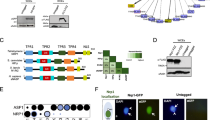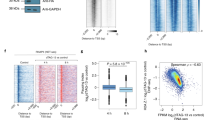Abstract
Multicellular organisms have evolved sophisticated mechanisms for responding to various developmental, environmental and physical stimuli by regulating transcription. The correlation of distribution of RNA Polymerase II (RNA Pol II) with transcription is well established in higher metazoans, however genome-wide information about its distribution in early metazoans, such as Hydra, is virtually absent. To gain insights into RNA Pol II-mediated transcription and chromatin organization in Hydra, we performed chromatin immunoprecipitation (ChIP)-coupled high-throughput sequencing (ChIP-seq) for RNA Pol II and Histone H3. Strikingly, we found that Hydra RNA Pol II is uniformly distributed across the entire gene body, as opposed to its counterparts in bilaterians such as human and mouse. Furthermore, correlation with transcriptome data revealed that the levels of RNA Pol II correlate with the magnitude of gene expression. Strikingly, the characteristic peak of RNA Pol II pause typically observed in bilaterians at the transcription start sites (TSSs) was not observed in Hydra. The RNA Pol II traversing ratio in Hydra was found to be intermediate to yeast and bilaterians. The search for factors involved in RNA Pol II pause revealed that RNA Pol II pausing machinery was most likely acquired first in Cnidaria. However, only a small subset of genes exhibited the promoter proximal RNP Pol II pause. Interestingly, the nucleosome occupancy is highest over the subset of paused genes as compared to total Hydra genes, which is another indication of paused RNA Pol II at these genes. Thus, this study provides evidence for the molecular basis of RNA Pol II pause early during the evolution of multicellular organisms.





Similar content being viewed by others
References
Adelman K and Lis JT 2012 Promoter-proximal pausing of RNA polymerase II: emerging roles in metazoans. Nat. Rev. Genet. 13 720–731
Amir-Zilberstein L, Ainbinder E, Toube L, Yamaguchi Y, Handa H and Dikstein R 2007 Differential regulation of NF-κB by elongation factors is determined by core promoter type. Mol. Cell. Biol. 27 5246–5259
Bosch TC 2007 Why polyps regenerate and we don’t: towards a cellular and molecular framework for Hydra regeneration. Dev. Biol. 303 421–433
Bosch TC 2012 What Hydra has to say about the role and origin of symbiotic interactions. Biol. Bull. 223 78–84
Broun M, Gee L, Reinhardt B and Bode HR 2005 Formation of the head organizer in hydra involves the canonical Wnt pathway. Development 132 2907–2916
Chapman JA, Kirkness EF, Simakov O, Hampson SE, Mitros T, Weinmaier T, Rattei T, Balasubramanian PG, Borman J and Busam D 2010 The dynamic genome of Hydra. Nature 464 592–596
Chen FX, Smith ER and Shilatifard A 2018 Born to run: control of transcription elongation by RNA polymerase II. Nat. Rev. Mol. Cell Biol. 19 464–478
Collins AG, Cartwright P, McFadden CS and Schierwater B 2005 Phylogenetic context and basal metazoan model systems. Integr. Comp. Biol. 45 585–594
Fröbius AC, Genikhovich G, Kürn U, Anton-Erxleben F and Bosch TC 2003 Expression of developmental genes during early embryogenesis of Hydra. Dev. Genes Evol. 213 445–455
Genikhovich G, Kürn U, Hemmrich G and Bosch TC 2006 Discovery of genes expressed in Hydra embryogenesis. Dev. Biol. 289 466–481
Gilchrist DA, Dos Santos G, Fargo DC, Xie B, Gao Y, Li L and Adelman K 2010 Pausing of RNA polymerase II disrupts DNA-specified nucleosome organization to enable precise gene regulation. Cell 143 540–551
Hendrix DA, Hong J-W, Zeitlinger J, Rokhsar DS and Levine MS 2008 Promoter elements associated with RNA Pol II stalling in the Drosophila embryo. Proc. Natl. Acad. Sci. U. S. A. 105 7762–7767
Hobmayer B, Jenewein M, Eder D, Eder M-K, Glasauer S, Gufler S, Hartl M and Salvenmoser W 2012 Stemness in Hydra—a current perspective. Int. J. Dev. Biol. 56 509–517
Hobmayer B, Rentzsch F, Kuhn K, Happel CM, von Laue CC, Snyder P, Rothbächer U and Holstein TW 2000 WNT signalling molecules act in axis formation in the diploblastic metazoan Hydra. Nature 407 186–189
Jimeno-González S, Payán-Bravo L, Muñoz-Cabello AM, Guijo M, Gutierrez G, Prado F and Reyes JC 2015 Defective histone supply causes changes in RNA polymerase II elongation rate and cotranscriptional pre-mRNA splicing. Proc. Natl. Acad. Sci. U. S. A. 112 14840–14845
Koster MJ, Snel B and Timmers HT 2015 Genesis of chromatin and transcription dynamics in the origin of species. Cell 161 724–736
Kwak H and Lis JT 2013 Control of transcriptional elongation. Annu. Rev. Genet. 47 483–508
Lemoine F, Correia D, Lefort V, Doppelt-Azeroual O, Mareuil F, Cohen-Boulakia S and Gascuel O 2019 NGPhylogeny. fr: new generation phylogenetic services for non-specialists. Nucleic Acids Res. 47 W260–W265
Letunic I and Bork P 2016 Interactive tree of life (iTOL) v3: an online tool for the display and annotation of phylogenetic and other trees. Nucleic Acids Res. 44 W242–W245
Levine M 2011 Paused RNA polymerase II as a developmental checkpoint. Cell 145 502–511
Liu X, Kraus WL and Bai X 2015 Ready, pause, go: regulation of RNA polymerase II pausing and release by cellular signaling pathways. Trends Biochem. Sci. 40 516–525
Mayer A, Landry HM and Churchman LS 2017 Pause & go: from the discovery of RNA polymerase pausing to its functional implications. Curr. Opin. Cell Biol. 46 72–80
Miller MA, Pfeiffer W and Schwartz T 2012 The CIPRES science gateway: enabling high-impact science for phylogenetics researchers with limited resources. Paper presented at: Proceedings of the 1st Conference of the Extreme Science and Engineering Discovery Environment: Bridging from the eXtreme to the campus and beyond (ACM)
Muse GW, Gilchrist DA, Nechaev S, Shah R, Parker JS, Grissom SF, Zeitlinger J and Adelman K 2007 RNA polymerase is poised for activation across the genome. Nat. Genet. 39 1507–1511
Narita T, Yamaguchi Y, Yano K, Sugimoto S, Chanarat S, Wada T, Kim D-K, Hasegawa J, Omori M and Inukai N 2003 Human transcription elongation factor NELF: identification of novel subunits and reconstitution of the functionally active complex. Mol. Cell. Biol. 23 1863–1873
Rahl PB, Lin CY, Seila AC, Flynn RA, McCuine S, Burge CB, Sharp PA and Young RA 2010 c-Myc regulates transcriptional pause release. Cell 141 432–445
Reddy PC, Barve A and Ghaskadbi S 2011 Description and phylogenetic characterization of common Hydra from India. Curr. Sci. 101 736–738
Reddy PC, Gungi A, Ubhe S, Pradhan SJ, Kolte A and Galande S (2019) Molecular signature of an ancient organizer regulated by Wnt/β-catenin signalling during primary body axis patterning in Hydra. Commun. Biol. 2 1–11
Reddy PC, Ubhe S, Sirwani N, Lohokare R and Galande S 2017 Rapid divergence of histones in Hydrozoa (Cnidaria) and evolution of a novel histone involved in DNA damage response in Hydra. Zool. (Jena) 123 53–63
Schwaiger M, Schönauer A, Rendeiro AF, Pribitzer C, Schauer A, Gilles AF, Schinko JB, Renfer E, Fredman D and Technau U 2014 Evolutionary conservation of the eumetazoan gene regulatory landscape. Genome Res. 24 639–650
Shao W and Zeitlinger J 2017 Paused RNA polymerase II inhibits new transcriptional initiation. Nat. Genet. 49 1045–1051
Tomczyk S, Fischer K, Austad S and Galliot B 2015 Hydra, a powerful model for aging studies. Invertebr. Reprod. Dev. 59 11–16
Török A, Schiffer PH, Schnitzler CE, Ford K, Mullikin JC, Baxevanis AD, Bacic A, Frank U and Gornik SG 2016 The cnidarian Hydractinia echinata employs canonical and highly adapted histones to pack its DNA. Epigenet. Chromatin 9 36
Wade JT and Struhl K 2008 The transition from transcriptional initiation to elongation. Curr. Opin. Genet. Dev. 18 130–136
Wada T, Takagi T, Yamaguchi Y, Ferdous A, Imai T, Hirose S, Sugimoto S, Yano K, Hartzog GA and Winston F 1998 DSIF, a novel transcription elongation factor that regulates RNA polymerase II processivity, is composed of human Spt4 and Spt5 homologs. Genes Dev. 12 343–356
Yamaguchi Y, Deléhouzée S and Handa H 2002 HIV and hepatitis delta virus: evolution takes different paths to relieve blocks in transcriptional elongation. Microb. Infect. 4 1169–1175
Yamaguchi Y, Filipovska J, Yano K, Furuya A, Inukai N, Narita T, Wada T, Sugimoto S, Konarska MM and Handa H 2001 Stimulation of RNA polymerase II elongation by hepatitis delta antigen. Science 293 124–127
Yamaguchi Y, Takagi T, Wada T, Yano K, Furuya A, Sugimoto S, Hasegawa J and Handa H 1999 NELF, a multisubunit complex containing RD, cooperates with DSIF to repress RNA polymerase II elongation. Cell 97 41–51
Ye T, Krebs AR, Choukrallah M-A, Keime C, Plewniak F, Davidson I and Tora L 2011 seqMINER: an integrated ChIP-seq data interpretation platform. Nucleic Acids Res. 39 e35–e35
Acknowledgements
The work was supported by the Centre of Excellence in Epigenetics program (BT/01/COE/09/07) of the Department of Biotechnology, Government of India to SG. KK acknowledges support from Genome Engineering Technologies programme (BT/PR25858/GET/119/169/2017) of the Department of Biotechnology, Government of India. PCR is supported by the Early Career Fellowship of the Wellcome Trust–DBT India Alliance (IA/E/16/1/503057).
Author information
Authors and Affiliations
Corresponding authors
Additional information
This artice is part of the Topical Collection: Chromatin Biology and Epigenetics.
Electronic supplementary material
Below is the link to the electronic supplementary material.
Rights and permissions
About this article
Cite this article
Reddy, P.C., Pradhan, S.J., Karmodiya, K. et al. Origin of RNA Polymerase II pause in eumetazoans: Insights from Hydra. J Biosci 45, 8 (2020). https://doi.org/10.1007/s12038-019-9979-y
Published:
DOI: https://doi.org/10.1007/s12038-019-9979-y




